Place Your Bets
The question of the day - at least in the popular financial press - appears to be, why are stocks rallying with the economy in free fall? Readers of my oftentimes meandering market missive likely already know the answer here. As we've discussed a time or twenty, the stock market is a discounting mechanism for future expectations. In other words, stocks look ahead, not back. And the bottom line is it looks like the market is currently looking ahead to better days.
Looking ahead to days when the economy is functioning again. To days when the majority of the unemployed are back to work. To days when there is a vaccine. To days when social distancing isn't necessary. And to days when the economy and life can return to "normal."
The key question in my mind is when will these days actually occur? And how long will it be before the economy returns to "normal?" Obviously, nobody knows the answers here.
In the meantime, the more pressing question is what does the "new normal" look like? You know, what does the rush to re-open hold for corporate America? Will the allowed 25% to 50% of capacity cut it? Or will businesses think fast and figure out ways to make up the shortfall?
Analyzing The Way Forward
While the questions are many and varied, one thing is for sure. Stocks are following any/all developments on the path forward very closely.
For example, the market appears to be betting that a vaccine will be developed in record time. We got good news on this front last week as we learned that Moderna's (MRNA) vaccine for coronavirus was approved for Phase 2 trials and that Phase 3 trials could begin as early this summer. And if things go well, this means a medical solution could be available as soon as 2021. This is indeed good news and allows stocks to look ahead.
Given that 2021 is less than 8 months away, this fits into the time frame the stock market typically "discounts" for. Therefore, further gains in the stock market are possible if traders continue to "look ahead" to normalization. And importantly, to the idea that we've seen the worst of the economic damage.
Given the immense importance of producing a medical solution to the virus problem (and of course, the potential profitability of such a solution), I have little doubt that a vaccine and a drug therapy will happen - and fast by historical standards.
But the next question is when should we expect the world's 7.5 billion inhabitants to be vaccinated?
While I am very excited about the progress that the folks at Oxford, Pfizer, Moderna, Gilead, etc. are making toward the development of a vaccine, I'm also a little concerned about the time frame involved to get everybody vaccinated. Because THIS is when things can go back to normal.
Then from the market's perspective, will this happen within the appropriate discounting window?
Yes, the market looks ahead. But can we really "pull forward" the expectations for better days by a year or more? Color me skeptical.
What Will You Bet On?
So from my seat, it's time to place your bets. If you believe that science will "get 'er done" before the end of the year, you should be buying here and on every dip.
But, if you believe that a solution will take longer, then caution is your watchword. And you will likely be looking to lighten up/take profits after the market's record-breaking joyride to the upside.
Expect Some Bumps Along The Way
Regardless of your near-term outlook/bet, it is probably a good idea to expect the longer-term road to normalization to be bumpy. There are any number of potholes such as another wave of the virus (especially now that the country is rushing to re-open), delays in the development of a vaccine, the contagion caused by oil's crash, a new phase of the trade war with China, etc.
Any of the above could easily cause investors who are currently looking past the economic nadir and across to the other side to recalculate their market math. In other words, any potholes that develop could cause the market's ride to experience a flat tire - I.E. a correction.
The Near-Term Narrative
But it is clear that stocks aren't worried about the long-term, complete virus fix here. No, traders appear to be focusing on what's going to happen within the next six months, when most states will be re-opened for business and the impact of the historic stimulus is being felt.
JPMorgan strategist Marko Kolanovic summed the situation up nicely. "While the collapse in economic activity is historic, so too is the global policy response to cushion the impact and support a recovery," Kolanovic wrote.
"We estimate the impact of Fed easing in both rates and credit [will] more than compensate for the temporary hit to corporate earnings when valuing the US market via discounted earnings," Kolanovic added.
Speaking of the Fed, traders appear to remain heartened about the outlook for Jay Powell & Company to stay "friendly" for a long - no, make that a very long time. For example, this week we learned that the Fed has pledged to keep rates at historic lows until the economy recovers. And the bottom line here is traders know that low rates are stimulative. Oh, and then there's the "Don't fight the Fed" rule. I'm pretty sure every investor on the planet knows that one by now.
Recognize Most Job Losses Aren't Permanent
While the press loves to promote the economic "death and destruction" happening out there, just reading the headlines can be misleading.
For example, a fact that didn't make the headlines is that 78% of the folks who "lost their job in April" said they were furloughed, meaning their unemployment is intended to be temporary. Additionally, CNBC reported the number of workers who described themselves as on temporary layoff (meaning they expect to be called back to work within six months) jumped from under two million to over 18 million last month.
The point is that temporary job losses due to a self-inflicted shutdown to keep folks safe and healthy is not the same as the traditional take on the term "unemployment." And yes, stocks may be discounting this as well as the fact that this is likely as bad as the "unemployment" situation will get.
The key going forward is to watch for the number of job losses that wind up being permanent. In short, the market will be monitoring where the jobs market will be in two to three months time. Understand that data supporting the idea that most of the "unemployment" will be temporary is mission critical to the bulls.
The Bottom Line
From my perch, the bottom line here is it's time for investors of all sizes and shapes to take a stand. Again, if you believe a medical solution will become a reality in the next six months, "Buy 'em!" But, if you see the future as uncertain or that it may take longer to get back to normal, some caution might be appropriate here. And with the roulette wheel now spinning, it is time to place your bets.
Weekly Market Model Review
Each week we do a disciplined, deep dive into our key market indicators and models. The overall goal of this exercise is to (a) remove emotion from the investment process, (b) stay "in tune" with the primary market cycles, and (c) remain cognizant of the risk/reward environment.
The Major Market Models
We start with six of our favorite long-term market models. These models are designed to help determine the "state" of the overall market.
There are two changes to report on the Primary Cycle board this week. However, I think it is worth keeping in mind that while the stock market rally continues unabated, my favorite big-picture market model board remains fairly weak. This week, NDR's Risk/Reward Model flipped from negative to neutral while the Global Risk model went the other direction. The end result is a historical average return that remains negative. So, while traders may continue to look ahead to better days, unless this board can perk up in a meaningful way, I'm going to keep my enthusiasm curbed.
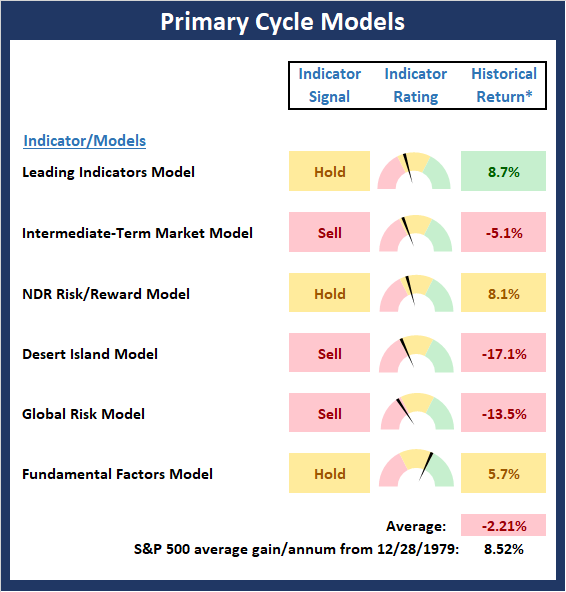
* Source: Ned Davis Research (NDR) as of the date of publication. Historical returns are hypothetical average annual performances calculated by NDR. Past performances do not guarantee future results or profitability - NOT INDIVIDUAL INVESTMENT ADVICE.
View My Favorite Market Models Online
The State of the Fundamental Backdrop
Next, we review the market's fundamental factors in the areas of interest rates, the economy, inflation, and valuations.
There are no changes to the Fundamental Factors board again this week. However, as I've been saying, both the earnings and economic pictures are likely worse than the model readings. For example, most analysts would likely concur that the economy is in a recession as it appears there is almost no possibility of avoiding two consecutive quarters of negative GDP readings. In addition, since earnings are projected to drop 20-25% for CY2020, my guess is the model will pick this up eventually. So, from my seat, I think you have to take these model readings with a grain of salt.
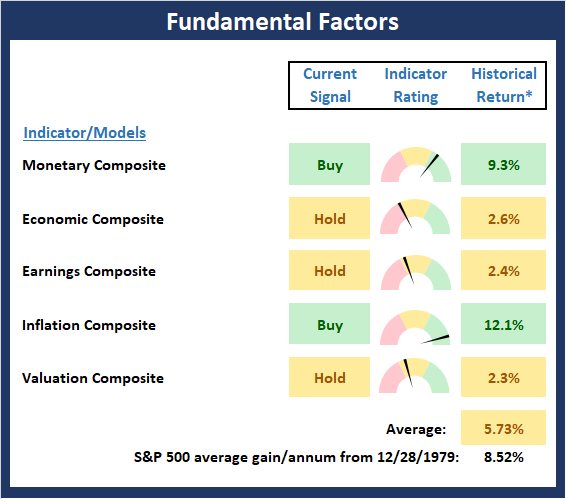
* Source: Ned Davis Research (NDR) as of the date of publication. Historical returns are hypothetical average annual performances calculated by NDR. Past performances do not guarantee future results or profitability - NOT INDIVIDUAL INVESTMENT ADVICE.
View Fundamental Indicator Board Online
The State of the Trend
After looking at the big-picture models and the fundamental backdrop, I like to look at the state of the trend. This board of indicators is designed to tell us about the overall technical health of the current trend.
There was some improvement on the Trend board this week as our ST Channel System upticked from negative to neutral. However, despite the fact that stocks have bounced hard over the past few weeks, there is still a fair amount of damage when looking at things from the intermediate- and longer-term trend perspectives. And with stocks currently moving largely sideways, I'll rate the current "state" of the overall trend as neutral.
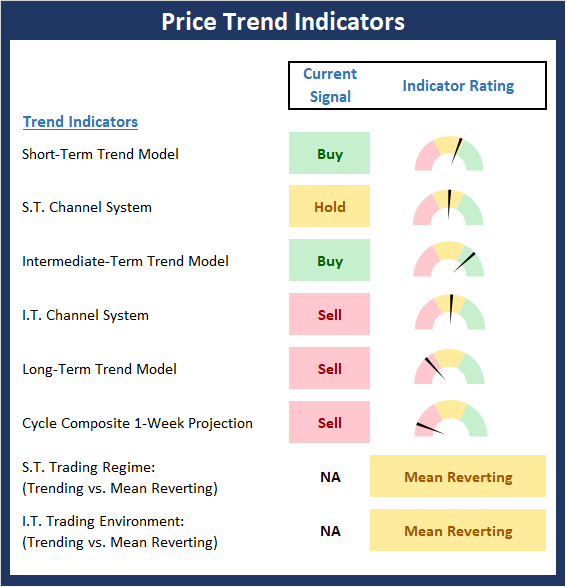
NOT INDIVIDUAL INVESTMENT ADVICE.
View Trend Indicator Board Online
The State of Internal Momentum
Next, we analyze the "oomph" behind the current trend via our group of market momentum indicators/models.
Despite the sideways action in the major indices, the Momentum Board improved a bit as both the Volume and Breadth Thrust indicators upticked to positive from neutral. So, for now, the bulls appear to have some momentum on their side.
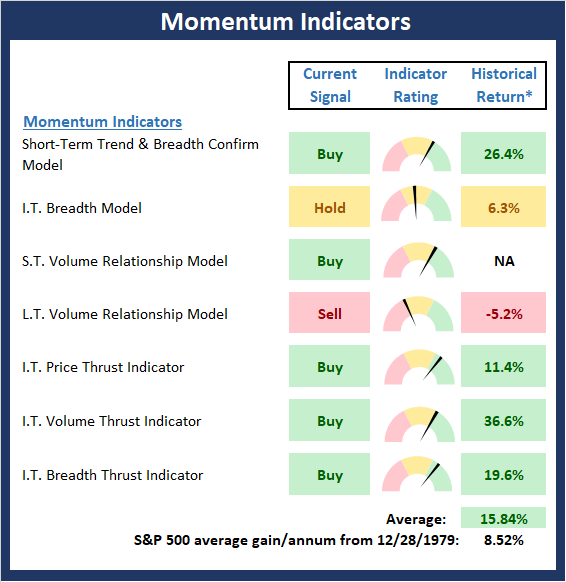
* Source: Ned Davis Research (NDR) as of the date of publication. Historical returns are hypothetical average annual performances calculated by NDR. Past performances do not guarantee future results or profitability - NOT INDIVIDUAL INVESTMENT ADVICE.
View Momentum Indicator Board Online
Early Warning Signals
Once we have identified the current environment, the state of the trend, and the degree of momentum behind the move, we then review the potential for a counter-trend move to begin. This batch of indicators is designed to suggest when the table is set for the trend to "go the other way."
Last week, we noted that the Early Warning board was suggesting that the table was now set for a counter-trend move, which in this case, would be down. But while the bears may still hold the edge here from an overbought/sold and sentiment perspective, the case is not as strong this week.
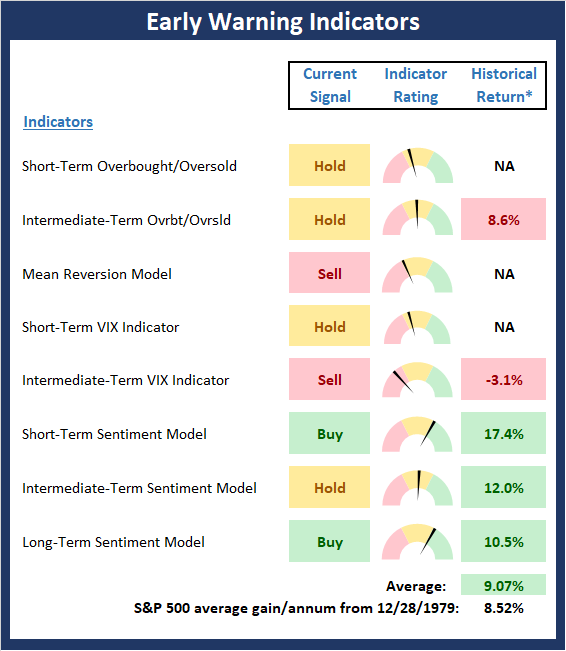
* Source: Ned Davis Research (NDR) as of the date of publication. Historical returns are hypothetical average annual performances calculated by NDR. Past performances do not guarantee future results or profitability - NOT INDIVIDUAL INVESTMENT ADVICE.
View Early Warning Indicator Board Online
Thought For The Day:
Tell me and I forget. Teach me and I remember. Involve me and I learn. -Benjamin Franklin
Wishing you green screens and all the best for a great day,

David D. Moenning
Founder, Chief Investment Officer
Heritage Capital Research
Disclosures
At the time of publication, Mr. Moenning held long positions in the following securities mentioned: None - Note that positions may change at any time.
Leading Indicators Model: A group of indicators that have historically shown tendencies to lead the market at major turning points.
Intermediate-Term Market Model: A composite model (model of models) focused on trend and momentum indicators which has been designed to provide identify intermediate-term trading opportunities.
Risk/Reward Model: A model-of-models intended to provide an overall view of the state of the risk/reward environment. The model includes tape, monetary, and sentiment indicators as well as 7 big-picture market model readings.
Desert Island Model: If I was stranded on a desert island with access to only one market model to manage money with, this would be the model. The model is a comprehensive model-of-models comprised of trend, momentum, mean reversion, economic, monetary, sentiment, and factor-based indicators/models.
External Factors Model: A model-of-models designed to provide a reading on the "macro state" of the market environment. The model is comprised of indicators/models in the areas of various index yields, industrial production, investors sentiment, and historic volatility.
Short-Term Trend-and-Breadth Signal Explained: History shows the most reliable market moves tend to occur when the breadth indices are in gear with the major market averages. When the breadth measures diverge, investors should take note that a trend reversal may be at hand. This indicator incorporates NDR's All-Cap Dollar Weighted Equity Series and A/D Line. From 1998, when the A/D line is above its 5-day smoothing and the All-Cap Equal Weighted Equity Series is above its 25-day smoothing, the equity index has gained at a rate of +32.5% per year. When one of the indicators is above its smoothing, the equity index has gained at a rate of +13.3% per year. And when both are below, the equity index has lost +23.6% per year.
Channel Breakout System Explained: The short-term and intermediate-term Channel Breakout Systems are modified versions of the Donchian Channel indicator. According to Wikipedia, "The Donchian channel is an indicator used in market trading developed by Richard Donchian. It is formed by taking the highest high and the lowest low of the last n periods. The area between the high and the low is the channel for the period chosen."
Intermediate-Term Trend-and-Breadth Signal Explained: This indicator incorporates NDR's All-Cap Dollar Weighted Equity Series and A/D Line. From 1998, when the A/D line is above its 45-day smoothing and the All-Cap Equal Weighted Equity Series is above its 45-day smoothing, the equity index has gained at a rate of +17.6% per year. When one of the indicators is above its smoothing, the equity index has gained at a rate of +6.5% per year. And when both are below, the equity index has lost -1.3% per year.
Cycle Composite Projections: The cycle composite combines the 1-year Seasonal, 4-year Presidential, and 10-year Decennial cycles. The indicator reading shown uses the cycle projection for the upcoming week.
Trading Mode Indicator: This indicator attempts to identify whether the current trading environment is "trending" or "mean reverting." The indicator takes the composite reading of the Efficiency Ratio, the Average Correlation Coefficient, and Trend Strength models.
Volume Relationship Models: These models review the relationship between "supply" and "demand" volume over the short- and intermediate-term time frames.
Price Thrust Model Explained: This indicator measures the 3-day rate of change of the Value Line Composite relative to the standard deviation of the 30-day average. When the Value Line's 3-day rate of change have moved above 0.5 standard deviation of the 30-day average ROC, a "thrust" occurs and since 2000, the Value Line Composite has gained ground at a rate of +20.6% per year. When the indicator is below 0.5 standard deviation of the 30-day, the Value Line has lost ground at a rate of -10.0% per year. And when neutral, the Value Line has gained at a rate of +5.9% per year.
Volume Thrust Model Explained: This indicator uses NASDAQ volume data to indicate bullish and bearish conditions for the NASDAQ Composite Index. The indicator plots the ratio of the 10-day total of NASDAQ daily advancing volume (i.e., the total volume traded in stocks which rose in price each day) to the 10-day total of daily declining volume (volume traded in stocks which fell each day). This ratio indicates when advancing stocks are attracting the majority of the volume (readings above 1.0) and when declining stocks are seeing the heaviest trading (readings below 1.0). This indicator thus supports the case that a rising market supported by heavier volume in the advancing issues tends to be the most bullish condition, while a declining market with downside volume dominating confirms bearish conditions. When in a positive mode, the NASDAQ Composite has gained at a rate of +38.3% per year, When neutral, the NASDAQ has gained at a rate of +13.3% per year. And when negative, the NASDAQ has lost at a rate of -15.99% per year.
Breadth Thrust Model Explained: This indicator uses the number of NASDAQ-listed stocks advancing and declining to indicate bullish or bearish breadth conditions for the NASDAQ Composite. The indicator plots the ratio of the 10-day total of the number of stocks rising on the NASDAQ each day to the 10-day total of the number of stocks declining each day. Using 10-day totals smooths the random daily fluctuations and gives indications on an intermediate-term basis. As expected, the NASDAQ Composite performs much better when the 10-day A/D ratio is high (strong breadth) and worse when the indicator is in its lower mode (weak breadth). The most bullish conditions for the NASDAQ when the 10-day A/D indicator is not only high, but has recently posted an extreme high reading and thus indicated a thrust of upside momentum. Bearish conditions are confirmed when the indicator is low and has recently signaled a downside breadth thrust. In positive mode, the NASDAQ has gained at a rate of +22.1% per year since 1981. In a neutral mode, the NASDAQ has gained at a rate of +14.5% per year. And when in a negative mode, the NASDAQ has lost at a rate of -6.4% per year.
Short-Term Overbought/sold Indicator: This indicator is the current reading of the 14,1,3 stochastic oscillator. When the oscillator is above 80 and the %K is above the %D, the indicator gives an overbought reading. Conversely, when the oscillator is below 20 and %K is below its %D, the indicator is oversold.
Intermediate-Term Overbought/sold Indicator: This indicator is a 40-day RSI reading. When above 57.5, the indicator is considered overbought and wnen below 45 it is oversold.
Mean Reversion Model: This is a diffusion model consisting of five indicators that can produce buy and sell signals based on overbought/sold conditions.
VIX Indicator: This indicators looks at the current reading of the VIX relative to standard deviation bands. When the indicator reaches an extreme reading in either direction, it is an indication that a market trend could reverse in the near-term.
Short-Term Sentiment Indicator: This is a model-of-models composed of 18 independent sentiment indicators designed to indicate when market sentiment has reached an extreme from a short-term perspective. Historical analysis indicates that the stock market's best gains come after an environment has become extremely negative from a sentiment standpoint. Conversely, when sentiment becomes extremely positive, market returns have been subpar.
Intermediate-Term Sentiment Indicator: This is a model-of-models composed of 7 independent sentiment indicators designed to indicate when market sentiment has reached an extreme from a intermediate-term perspective. Historical analysis indicates that the stock market's best gains come after an environment has become extremely negative from a sentiment standpoint. Conversely, when sentiment becomes extremely positive, market returns have been subpar.
Long-Term Sentiment Indicator: This is a model-of-models composed of 6 independent sentiment indicators designed to indicate when market sentiment has reached an extreme from a long-term perspective. Historical analysis indicates that the stock market's best gains come after an environment has become extremely negative from a sentiment standpoint. Conversely, when sentiment becomes extremely positive, market returns have been subpar.
Absolute Monetary Model Explained: The popular cliche, "Don't fight the Fed" is really a testament to the profound impact that interest rates and Fed policy have on the market. It is a proven fact that monetary conditions are one of the most powerful influences on the direction of stock prices. The Absolute Monetary Model looks at the current level of interest rates relative to historical levels and Fed policy.
Relative Monetary Model Explained: The "relative" monetary model looks at monetary indicators relative to recent levels as well as rates of change and Fed Policy.
Economic Model Explained: During the middle of bull and bear markets, understanding the overall health of the economy and how it impacts the stock market is one of the few truly logical aspects of the stock market. When our Economic model sports a "positive" reading, history (beginning in 1965) shows that stocks enjoy returns in excess of 21% per year. Yet, when the model's reading falls into the "negative" zone, the S&P has lost nearly -25% per year. However, it is vital to understand that there are times when good economic news is actually bad for stocks and vice versa. Thus, the Economic model can help investors stay in tune with where we are in the overall economic cycle.
Inflation Model Explained: They say that "the tape tells all." However, one of the best "big picture" indicators of what the market is expected to do next is inflation. Simply put, since 1962, when the model indicates that inflationary pressures are strong, stocks have lost ground. Yet, when inflationary pressures are low, the S&P 500 has gained ground at a rate in excess of 13%. The bottom line is inflation is one of the primary drivers of stock market returns.
Valuation Model Explained: If you want to get analysts really riled up, you need only to begin a discussion of market valuation. While the question of whether stocks are overvalued or undervalued appears to be a simple one, the subject is actually extremely complex. To simplify the subject dramatically, investors must first determine if they should focus on relative valuation (which include the current level of interest rates) or absolute valuation measures (the more traditional readings of Price/Earnings, Price/Dividend, and Price/Book Value). We believe that it is important to recognize that environments change. And as such, the market's focus and corresponding view of valuations are likely to change as well. Thus, we depend on our Valuation Models to help us keep our eye on the ball.
Disclosures
NOT INVESTMENT ADVICE. The opinions and forecasts expressed herein are those of Mr. David Moenning and Heritage Capital Research and may not actually come to pass. The opinions and viewpoints regarding the future of the markets should not be construed as recommendations. The analysis and information in this report is for informational purposes only. No part of the material presented in this report is intended as an investment recommendation or investment advice. Neither the information nor any opinion expressed constitutes a solicitation to purchase or sell securities or any investment program.
Any investment decisions must in all cases be made by the reader or by his or her investment adviser. Do NOT ever purchase any security without doing sufficient research. There is no guarantee that the investment objectives outlined will actually come to pass. All opinions expressed herein are subject to change without notice. Neither the editor, employees, nor any of their affiliates shall have any liability for any loss sustained by anyone who has relied on the information provided.
Mr. Moenning of Heritage Capital Research is an investment adviser representative of Eastsound Capital Advisors, LLC, a registered investment advisor. The adviser may not transact business in states where it is not appropriately registered, excluded or exempted from registration. Individualized responses to persons that involve either the effecting of transaction in securities, or the rendering of personalized investment advice for compensation, will not be made without registration or exemption.
Mr. Moenning and Heritage Capital Research may at times have positions in the securities referred to and may make purchases or sales of these securities while publications are in circulation. Positions may change at any time.
The analysis provided is based on both technical and fundamental research and is provided "as is" without warranty of any kind, either expressed or implied. Although the information contained is derived from sources which are believed to be reliable, they cannot be guaranteed.
The author neither endorses nor warrants the content of this site, any embedded advertisement, or any linked resource. The author or his managed funds may hold either long or short positions in the referenced securities. Republication rights must be expressly granted by author in writing.
Investments in equities carry an inherent element of risk including the potential for significant loss of principal. Past performance is not an indication of future results.

